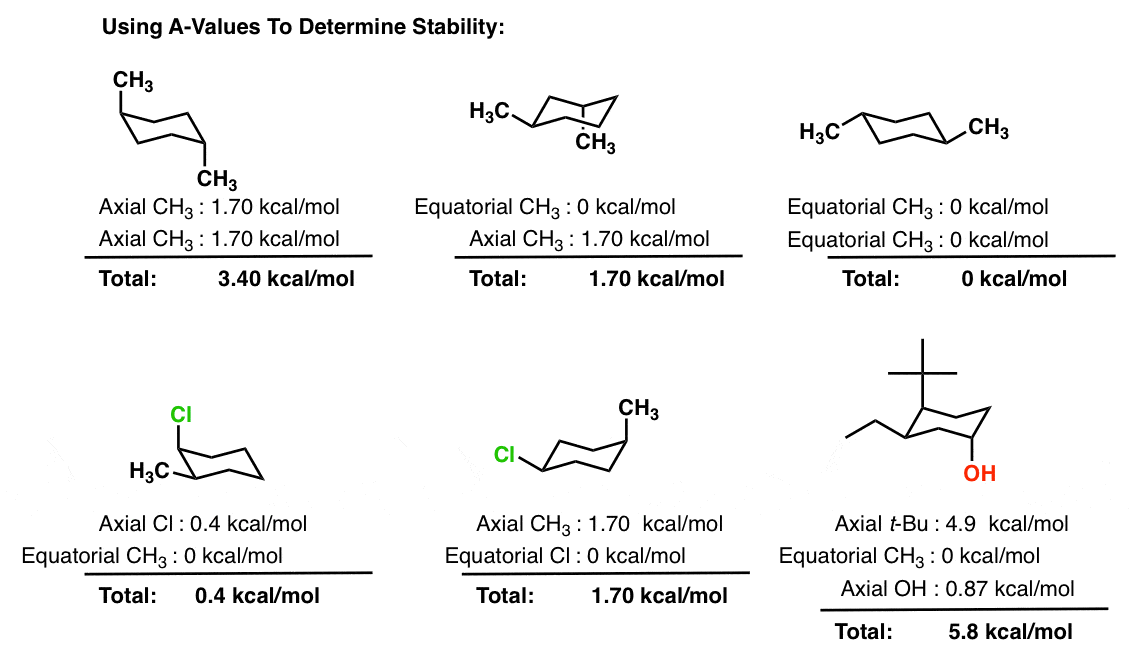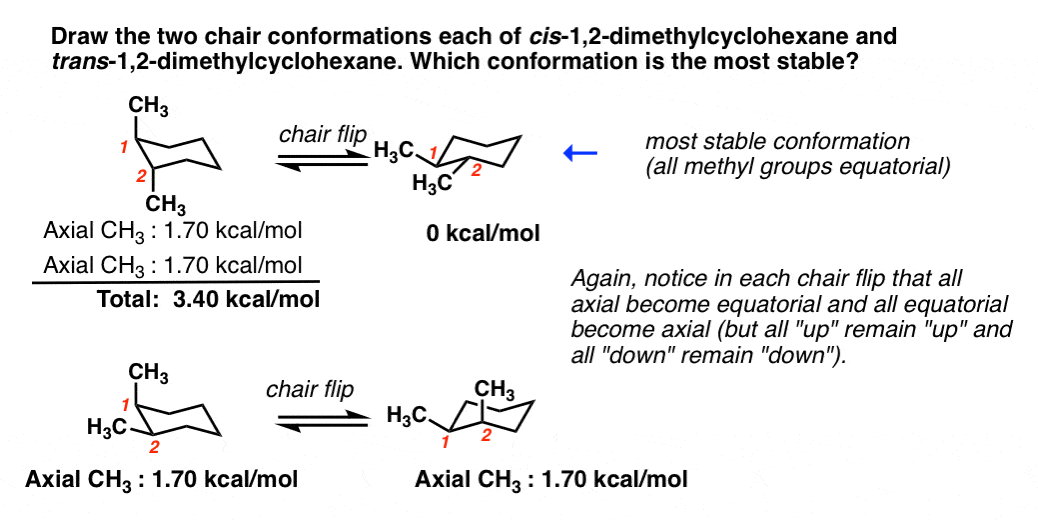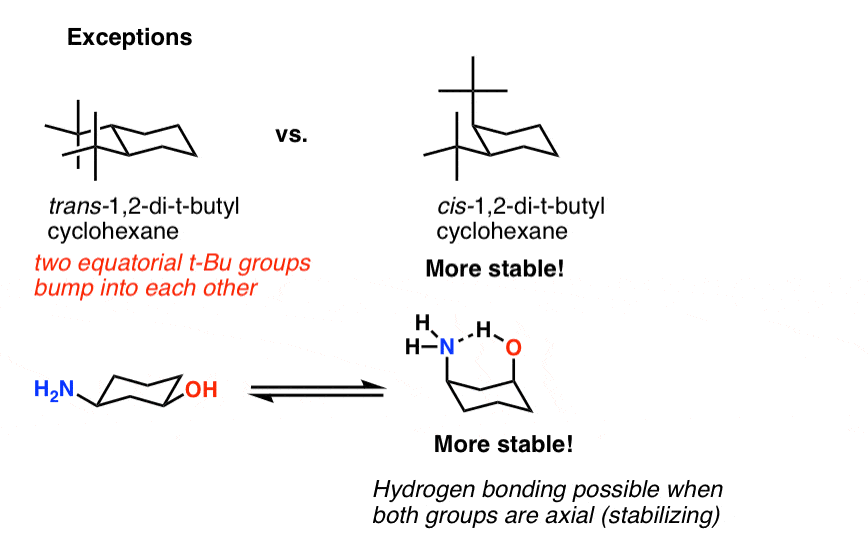Finding The Most Stable Conformation Of A Cyclohexane Chair
You’re given a structure with two or more substituents on a cyclohexane ring, and you’re asked to draw the most stable conformation. How do you do that? That’s what this post is about.
Table of Contents
- A-Values Are A Useful Measure of Bulkiness
- A-Values Are Additive
- Example: Determining The Most Stable Conformation Of cis– And trans- 1,2-Dimethylcyclohexane
- To Determine Chair Conformation Stability, Add Up The A-Values For Each Axial Substituent. The Lower The Number, The More Stable It is.
- Summary: Stability of Cyclohexane Conformations
- Notes
- (Advanced) References and Further Reading
1. A-Values Are A Useful Measure Of Bulkiness
In the last post, we introduced A values and said they were a useful tool for determining which groups are “bulkiest” on a cyclohexane ring. (See post: Ranking the Bulkiness Of Substituents On Cyclohexane Rings With A-Values)
The greater the A-value (bulk), the more favoured the equatorial conformer will be (versus axial). We saw that hydroxyl groups (OH) have a relatively low A-value (0.87), methyl groups are higher (1.70) and the t-butyl group is one of the highest of all (>4.5) .
We also saw that by knowing the A value (which is essentially the energy difference in kcal/mol) we could figure out the % of axial and equatorial conformers in solution using the formula ΔG = –RT ln K
In this post we’re going to extend this concept and see what happens when we have MORE than one group on a cyclohexane ring.
2. A-Values Are Additive
The nice thing about A values is that they are additive. We can make the (safe) assumption that groups on adjacent carbons don’t bump into one another [Note 1] so figuring out the torsional strain of a cyclohexane chair is simply a matter of adding up the A values of the axial groups in any chair conformation.
We can apply this to cyclohexanes with two, three, or even more substituents.
Here are some examples:

3. Example: Determining The Most Stable Conformation Of cis- And trans– 1,2-Dimethylcyclohexane
That’s nice, you might say, but when might we ever want to do that? The key example is when we are examining two chair conformers of the same molecule. A-values are essential in helping us figure out which one is most stable.
Here’s an example of the type of question we might be asked: draw the two chair conformations of cis-1,2-dimethylcyclohexane and trans-1,2-dimethylcyclohexane, and determine which is most stable.

- Here, I’ve started by drawing the conformer of trans-1,2-dimethylcyclohexane where both CH3 groups are axial (remember – it’s trans because one group is up and one group is down).
- The two axial methyl groups give a total of 3.4 kcal/mol of torsional strain.
- A chair flip converts all axial groups to equatorial and vice versa (but all “up” groups remain “up” and all “down” groups remain “down”! ) giving us a conformer where both methyl groups are now equatorial (and therefore do not contribute any strain).
- Therefore the di-equatorial conformer is favoured by 3.4 kcal/mol. [If we wanted to, we could also figure out the equilibrium constant here: K is about 340, giving a ratio 99.6: 1 in favour of the di-equatorial conformer.]
- In the case of cis-1,2-dimethylcyclohexane, I’ve started by drawing an axial CH3 at C-1 and an equatorial CH3 at C-2 (note that my designation of C-1 and C-2 is completely arbitrary). This has a strain energy of 1.70 kcal/mol due to the single axial CH3.
- When we do the chair flip, we convert all axial groups to equatorial and all equatorial to axial, giving us…. a new chair which still has one methyl group equatorial and one axial! The same energy, in other words (1.70 kcal/mol). [The equilibrium constant here is 1, giving a 50:50 ratio]
4. To Determine Chair Conformation Stability, Add Up The A-Values For Each Axial Substituent. The Lower The Number The More Stable It Is
Now that we’ve drawn all four possibilities, we can rank them in order of stability if we want, and then determine that for the two isomers of 1,2-dimethylcylohexane, the di-equatorial conformer of trans-1,2-dimethylcyclohexane is the most stable.

5. Summary: Chair Conformation Stability
In the next post we’re going to talk about fused cyclohexane rings, and ask how we can apply what we’ve already learned to understand more about the stability of the conformers of these molecules.
Notes
Note 1. One key exception to the “A values are additive” assumption is 1,2-di-t-butyl cyclohexane, in which the trans form is actually less stable than the cis despite the fact that both groups are equatorial in the trans. That’s because the two t-butyl groups are held together so closely in space that there is significant “1,2” strain (Van der Waals strain). [Note: it turns out in the trans isomer, the diaxial conformation is favored by 6.2 kcal/mol ! see the References section. ]
Another exception is the amino alcohol below. What force might be responsible for the fact that the axial conformer is favoured in equilibrium conditions?

